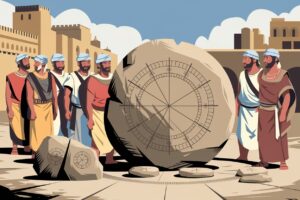It’s almost poetic how the number 60—so woven into our modern lives—dates back to a civilization that flourished over 5,000 years ago. The Sumerians of ancient Mesopotamia, nestled between the Tigris and Euphrates rivers, developed the sexagesimal (base-60) numerical system, a mathematical marvel that continues to influence how we measure time and space. But why 60? Why not a simpler base like 10, which aligns neatly with our fingers? The answer lies in both practicality and ingenuity.
The first reason is divisibility. Sixty is a highly composite number, meaning it can be evenly divided by a wide array of smaller numbers: 1, 2, 3, 4, 5, 6, 10, 12, 15, 20, 30, and of course, 60 itself. This made it ideal for calculations in trade, construction, and early science, where fractions were essential. Unlike modern decimal systems, which often involve clunky repeating decimals, the base-60 system allowed for clean, precise divisions—a critical advantage in a world without calculators or even the concept of zero.

There’s also a fascinating theory tied to finger counting. While most of us count to 10 on our fingers, the Sumerians may have counted the three segments of each finger (excluding the thumb) on one hand, pointing to them with the fingers of the other hand. This method could tally up to 60, providing a practical, physical basis for their numerical preference.
Another hypothesis suggests cultural synthesis. The Sumerians might have blended two earlier systems: a base-12 system (possibly derived from lunar cycles or Zodiac constellations) and a base-5 system (perhaps linked to counting fingers). The result? A harmonious base-60 system that combined the strengths of both.
This revolutionary system didn’t just stay in Mesopotamia. It was adopted by the Babylonians, who refined and expanded it, embedding it into astronomical calculations and geometry. Today, echoes of this ancient brilliance persist in every clock we glance at and every angle we measure—proof that the Sumerians’ mathematical legacy is as enduring as time itself.
The Birth of the 60-Minute Hour
The 60-minute hour isn’t just a relic of ancient timekeeping—it’s a testament to the mathematical ingenuity of the Sumerians, who lived in Mesopotamia over 5,000 years ago. Their choice of a base-60, or sexagesimal, numerical system wasn’t arbitrary. Sixty is a remarkably versatile number, divisible by 1, 2, 3, 4, 5, 6, 10, 12, 15, 20, 30, and 60 itself. This exceptional divisibility allowed for precise calculations, a critical advantage in a world that lacked modern tools like calculators or the concept of repeating decimals. For the Sumerians, mathematics wasn’t just about numbers—it was a way to organize life, from trade to astronomy.
This numerical system naturally extended to their division of time. Using shadow clocks and other rudimentary tools, they divided the day into manageable segments. The hour, as we know it, was broken into 60 minutes, each minute further divided into 60 seconds—creating a structure that could accommodate both practical needs and astronomical observations. The sexagesimal system also aligned with the Sumerians’ understanding of celestial cycles, such as the movement of stars and planets, which played a vital role in their culture and religion.
The brilliance of this system ensured its survival. The Babylonians inherited and refined it, applying the same principles to their 360-degree circle and their calendar, which divided the year into 12 months of 30 days each. From there, the idea spread across civilizations, influencing Greek and Roman scholars, and eventually shaping medieval European timekeeping. By the 16th century, the invention of mechanical clocks—with minute and second hands—cemented the Sumerians’ ancient innovation into the daily rhythm of modern life.
Today, while we measure time with atomic precision, the 60-minute hour remains a legacy of Sumerian ingenuity. It’s a reminder that even the simplest-seeming conventions—like the ticking of a clock—are often rooted in profound historical and mathematical insights.
The 360-Degree Circle: A Mathematical Masterpiece
The division of a circle into 360 degrees is one of the most enduring legacies of ancient Mesopotamian mathematics, specifically rooted in the Sumerian base-60, or sexagesimal, number system. But why 360? At first glance, it might seem arbitrary, yet the choice reveals a stunning combination of mathematical practicality and astronomical insight.
The number 360 was likely chosen for its exceptional divisibility. It can be evenly divided by 24 different numbers, including 2, 3, 4, 5, 6, 10, 12, 15, 20, 30, 60, and others. This made it highly versatile for calculations in geometry, astronomy, and engineering, allowing ancient mathematicians to break down complex problems into manageable parts. Imagine trying to divide a circle into equal sections for astronomical charts or architectural designs—360 made such tasks simpler and more precise.
Astronomy played an equally critical role in this decision. Babylonian astronomers, inheriting Sumerian principles, observed that the solar year was approximately 360 days (a rounded figure, as we now know it’s closer to 365.25). Dividing the circle of the heavens into 360 degrees allowed them to map the sun’s movement across the sky with remarkable accuracy. Each degree corresponded roughly to one day, creating a celestial calendar that aligned with their observations of the natural world.
Another theory suggests that 360 degrees provided a middle ground between the solar year and the lunar year, which is about 354 days. This compromise offered a consistent framework for tracking celestial cycles, a task central to both timekeeping and religious rituals in ancient Mesopotamia.
This innovation didn’t end with the Babylonians. The Greeks, including mathematicians like Hipparchus and Ptolemy, adopted the 360-degree system for their own astronomical and geometric studies. From there, it spread to the Islamic world and eventually Europe, embedding itself in navigation, mapmaking, and even modern trigonometry.
Today, whether you’re navigating with GPS, calculating angles in a math class, or marveling at the stars, you’re engaging with a system that began over 4,000 years ago. The 360-degree circle isn’t just a mathematical construct—it’s a testament to the ingenuity and foresight of ancient civilizations.
The Sumerians’ Legacy in Modern Timekeeping
The Sumerians might not have foreseen their enduring influence on our daily lives, but their sexagesimal (base-60) numerical system has become the backbone of modern timekeeping. Over 5,000 years ago, they divided time into intervals that would later evolve into the 60-minute hour and 60-second minute—standards that remain globally accepted today. This innovation wasn’t arbitrary; the number 60’s unique divisibility (by 1, 2, 3, 4, 5, 6, 10, 12, 15, 20, 30, and 60) made it an invaluable tool for precise calculations, especially in astronomy and mathematics.
The Babylonians, inheriting the Sumerian system, used it to chart celestial movements, a practice later adopted and refined by Greek and Roman scholars. These ancient astronomers relied on the sexagesimal framework to measure angles and time, embedding it into disciplines like navigation and trigonometry. By the Middle Ages, Islamic mathematicians preserved and expanded upon this knowledge, reintroducing it to Europe through Spain, where it became integral to scientific and technological advancements.
Even the invention of mechanical clocks in the 14th century adhered to the Sumerian model, with minute and second hands gaining prominence by the 16th century. Today, while atomic clocks define the “second” with cesium atoms’ vibrations, the structure of timekeeping remains rooted in the Sumerians’ ancient system. Their legacy isn’t just historical—it’s ticking away on every clock around the world.
The Influence of Sumerian Mathematics on Astronomy
The Sumerians’ base-60 number system wasn’t just a mathematical marvel—it was the foundation of their astronomical breakthroughs. By leveraging the versatility of 60, a number divisible by 12 factors (including 1, 2, 3, 4, 5, and 6), Sumerian astronomers could conduct precise calculations for tracking celestial bodies. This system allowed them to divide the sky into manageable sections, eventually influencing the creation of the 360-degree circle, an innovation that remains central to modern geometry and astronomy.
Sumerian astronomers used the sexagesimal system to map the heavens with unprecedented accuracy. They divided time and space into segments that made it easier to measure celestial movements—essential for predicting eclipses, determining lunar cycles, and even establishing agricultural calendars. These calculations were so precise that they laid the groundwork for later civilizations, such as the Babylonians, who inherited and refined these methods. For instance, the Babylonians used the same system to develop detailed star charts and trigonometric tables, which were indispensable for navigation and early scientific inquiry.
The Sumerians’ legacy in astronomy didn’t end with their empire. Their innovations reached ancient Greece, where scholars like Hipparchus and Ptolemy adopted the sexagesimal framework for their own astronomical models. Even today, when we measure angles or track time in units of 60, we’re echoing the brilliance of Sumerian mathematics. It’s a testament to how their celestial insights continue to shape our understanding of the universe.
Why 60? The Practicality of Divisibility
The Sumerians’ choice of 60 as the cornerstone of their numerical system wasn’t arbitrary—it was a masterstroke of mathematical ingenuity. In a world without calculators or even the concept of zero, they needed a system that could simplify calculations in trade, construction, and astronomy. Enter 60, a number uniquely suited to the task. Why? Because it’s divisible by 1, 2, 3, 4, 5, 6, 10, 12, 15, 20, 30, and, of course, 60 itself. This remarkable flexibility made it easy to split into fractions, an essential feature in a society where dividing goods, land, or time was a daily necessity.
Imagine trying to divide a circle—or a bushel of grain—into equal parts. With 60, you could carve it into halves, thirds, quarters, or even fifteenths without running into messy remainders. This ease of divisibility wasn’t just practical; it was transformative. In architecture, it allowed for precise measurements and proportional designs. In trade, merchants could calculate shares and weights with minimal effort. And in astronomy, dividing the heavens into 360 degrees (a multiple of 60) enabled early stargazers to track celestial movements with astonishing accuracy.
This system wasn’t just about convenience—it laid the groundwork for lasting innovations. The Sumerians’ base-60 approach influenced everything from the 60-minute hour to the 360-degree circle, concepts that remain integral to modern science and timekeeping. Their choice of 60 wasn’t merely a quirk of ancient mathematics; it was a legacy of logic, precision, and enduring relevance.
The Sumerians’ Enduring Impact on Human Civilization
The Sumerians, pioneers of human civilization, left a legacy so profound that its echoes still shape our daily lives. At the heart of their contributions lies their revolutionary base-60 (sexagesimal) number system, a mathematical marvel that has withstood the test of millennia. Developed around 3100 B.C., this system became the cornerstone of timekeeping, geometry, and astronomy—disciplines integral to human progress.
Their sexagesimal system wasn’t arbitrary; it was ingeniously practical. The number 60, with its 12 divisors (1, 2, 3, 4, 5, 6, 10, 12, 15, 20, 30, and 60), allowed for precise calculations, whether dividing land, measuring grains, or mapping the heavens. This divisibility made it indispensable for trade and science, enabling the Sumerians to establish innovations like the 360-degree circle and the division of time into 60-minute hours and 60-second minutes. These concepts, passed down through the Babylonians, Greeks, and Romans, became universal standards still in use today.
The Sumerians’ impact extended beyond mathematics. Their mastery of celestial movements laid the groundwork for astronomy, influencing everything from the calendars we follow to the GPS coordinates that guide us. Even as modern timekeeping shifted to atomic clocks, the Sumerian framework remains fundamental. Their enduring legacy is a testament to the timelessness of human ingenuity.







